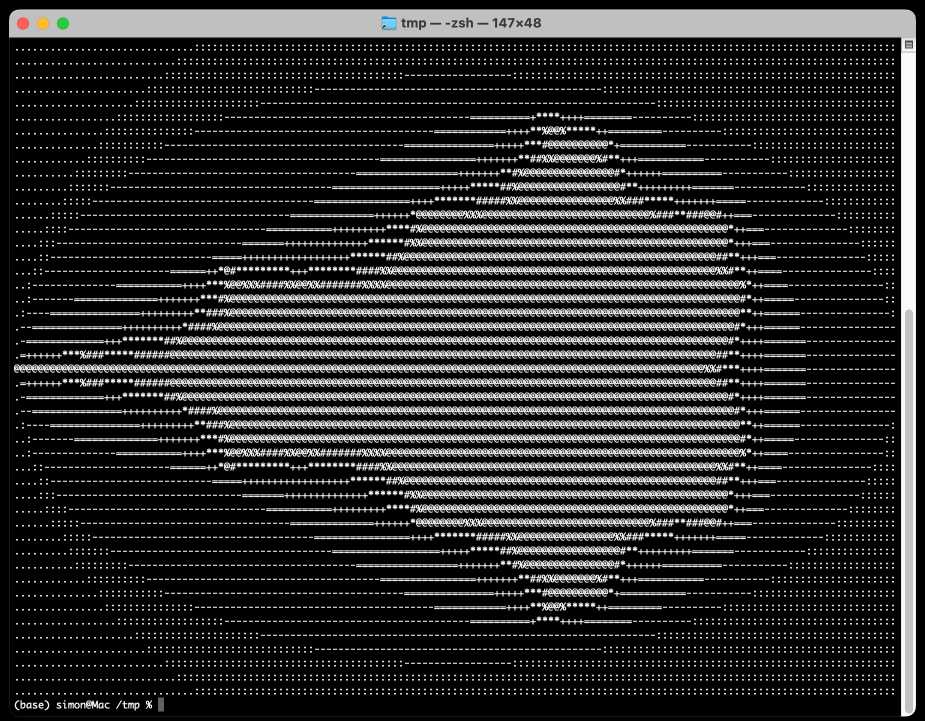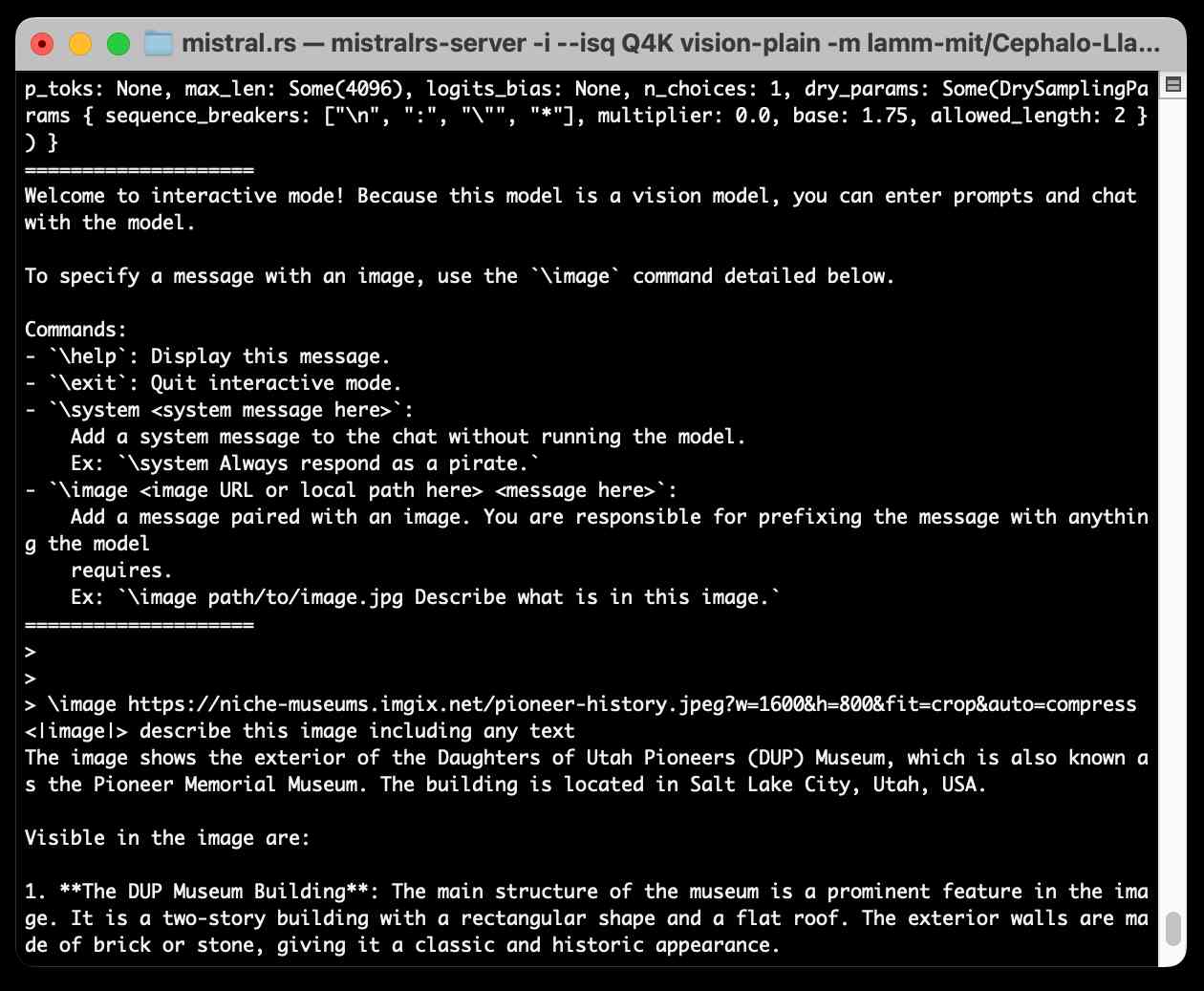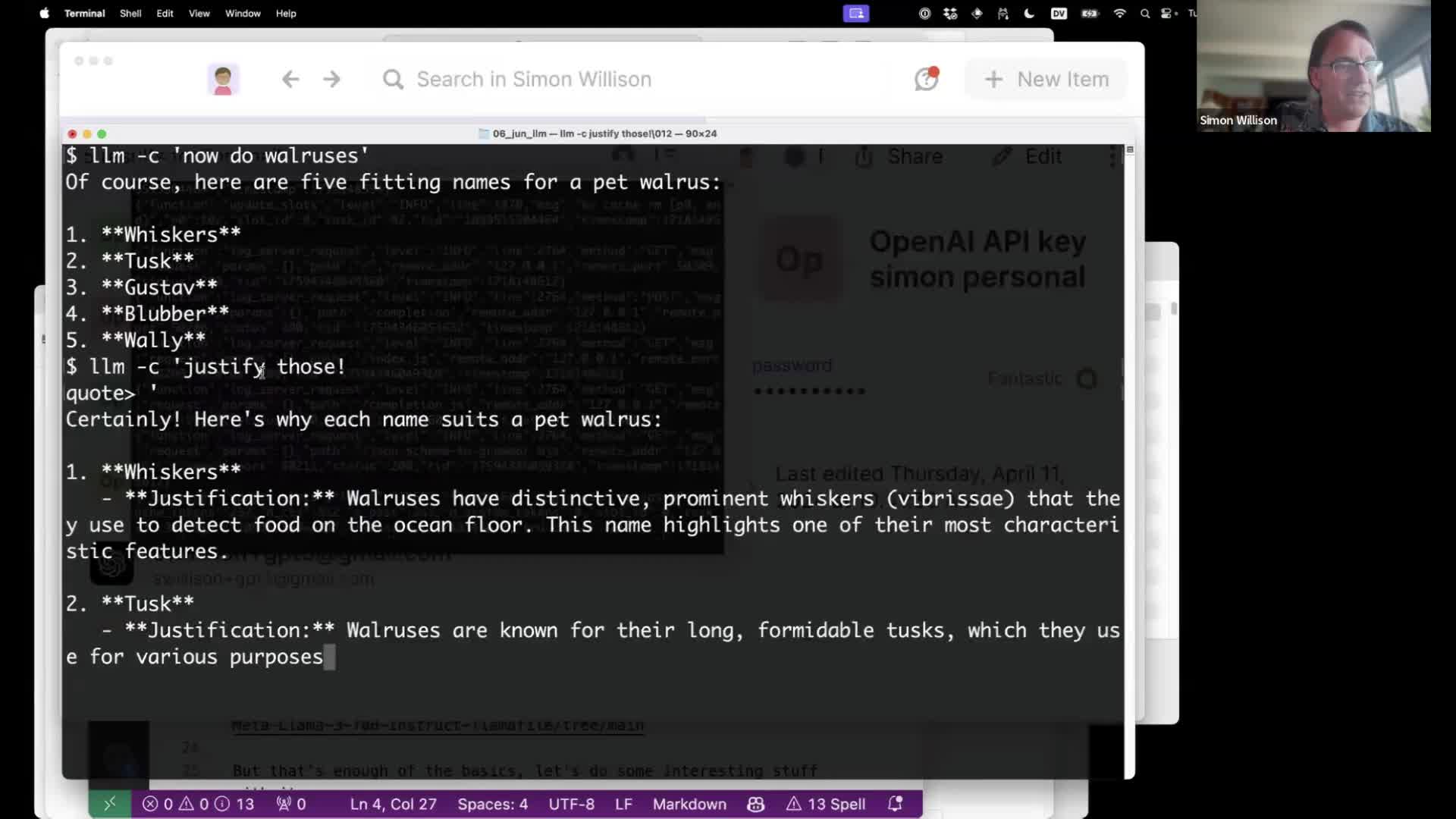145 posts tagged “local-llms”
LLMs that can run on consumer hardware like laptops or mobile phones.
2024
Open WebUI. I tried out this open source (MIT licensed, JavaScript and Python) localhost UI for accessing LLMs today for the first time. It's very nicely done.
I ran it with uvx like this:
uvx --python 3.11 open-webui serve
On first launch it installed a bunch of dependencies and then downloaded 903MB to ~/.cache/huggingface/hub/models--sentence-transformers--all-MiniLM-L6-v2 - a copy of the all-MiniLM-L6-v2 embedding model, presumably for its RAG feature.
It then presented me with a working Llama 3.2:3b chat interface, which surprised me because I hadn't spotted it downloading that model. It turns out that was because I have Ollama running on my laptop already (with several models, including Llama 3.2:3b, already installed) - and Open WebUI automatically detected Ollama and gave me access to a list of available models.
I found a "knowledge" section and added all of the Datasette documentation (by dropping in the .rst files from the docs) - and now I can type # in chat to search for a file, add that to the context and then ask questions about it directly.
I selected the spatialite.rst.txt file, prompted it with "How do I use SpatiaLite with Datasette" and got back this:
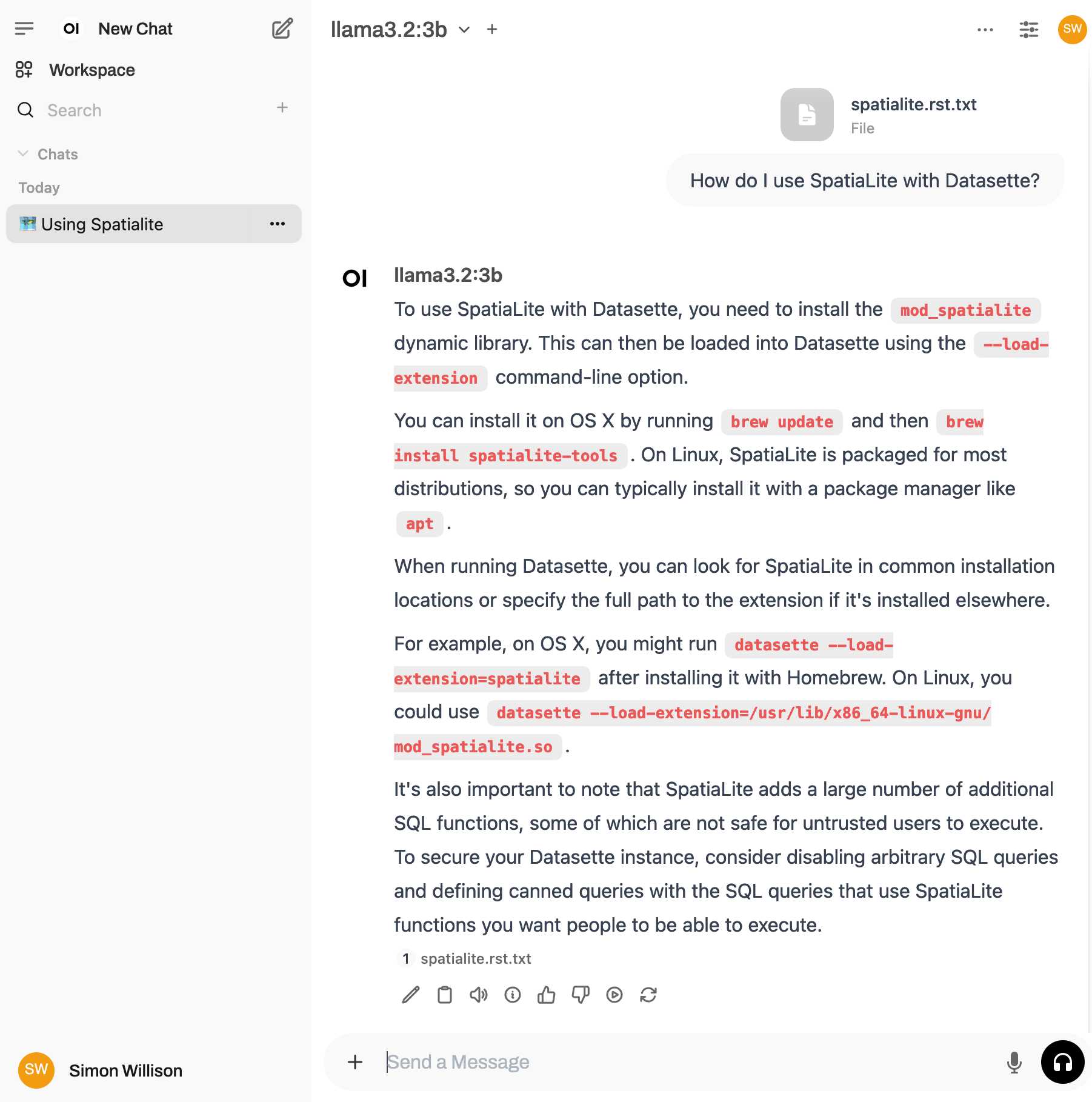
That's honestly a very solid answer, especially considering the Llama 3.2 3B model from Ollama is just a 1.9GB file! It's impressive how well that model can handle basic Q&A and summarization against text provided to it - it somehow has a 128,000 token context size.
Open WebUI has a lot of other tricks up its sleeve: it can talk to API models such as OpenAI directly, has optional integrations with web search and custom tools and logs every interaction to a SQLite database. It also comes with extensive documentation.
Trying out QvQ—Qwen’s new visual reasoning model
I thought we were done for major model releases in 2024, but apparently not: Alibaba’s Qwen team just dropped the Apache 2.0 licensed Qwen licensed (the license changed) QvQ-72B-Preview, “an experimental research model focusing on enhancing visual reasoning capabilities”.
I can now run a GPT-4 class model on my laptop
Meta’s new Llama 3.3 70B is a genuinely GPT-4 class Large Language Model that runs on my laptop.
[... 2,905 words]Meta AI release Llama 3.3. This new Llama-3.3-70B-Instruct model from Meta AI makes some bold claims:
This model delivers similar performance to Llama 3.1 405B with cost effective inference that’s feasible to run locally on common developer workstations.
I have 64GB of RAM in my M2 MacBook Pro, so I'm looking forward to trying a slightly quantized GGUF of this model to see if I can run it while still leaving some memory free for other applications.
Update: Ollama have a 43GB GGUF available now. And here's an MLX 8bit version and other MLX quantizations.
Llama 3.3 has 70B parameters, a 128,000 token context length and was trained to support English, German, French, Italian, Portuguese, Hindi, Spanish, and Thai.
The model card says that the training data was "A new mix of publicly available online data" - 15 trillion tokens with a December 2023 cut-off.
They used "39.3M GPU hours of computation on H100-80GB (TDP of 700W) type hardware" which they calculate as 11,390 tons CO2eq. I believe that's equivalent to around 20 fully loaded passenger flights from New York to London (at ~550 tons per flight).
Update 19th January 2025: On further consideration I no longer trust my estimate here: it's surprisingly hard to track down reliable numbers but I think the total CO2 used by those flights may be more in the order of 200-400 tons, so my estimate for Llama 3.3 70B should have been more in the order of between 28 and 56 flights. Don't trust those numbers either though!
SmolVLM—small yet mighty Vision Language Model. I've been having fun playing with this new vision model from the Hugging Face team behind SmolLM. They describe it as:
[...] a 2B VLM, SOTA for its memory footprint. SmolVLM is small, fast, memory-efficient, and fully open-source. All model checkpoints, VLM datasets, training recipes and tools are released under the Apache 2.0 license.
I've tried it in a few flavours but my favourite so far is the mlx-vlm approach, via mlx-vlm author Prince Canuma. Here's the uv recipe I'm using to run it:
uv run \
--with mlx-vlm \
--with torch \
python -m mlx_vlm.generate \
--model mlx-community/SmolVLM-Instruct-bf16 \
--max-tokens 500 \
--temp 0.5 \
--prompt "Describe this image in detail" \
--image IMG_4414.JPG
If you run into an error using Python 3.13 (torch compatibility) try uv run --python 3.11 instead.
This one-liner installs the necessary dependencies, downloads the model (about 4.2GB, saved to ~/.cache/huggingface/hub/models--mlx-community--SmolVLM-Instruct-bf16) and executes the prompt and displays the result.
I ran that against this Pelican photo:
The model replied:
In the foreground of this photograph, a pelican is perched on a pile of rocks. The pelican’s wings are spread out, and its beak is open. There is a small bird standing on the rocks in front of the pelican. The bird has its head cocked to one side, and it seems to be looking at the pelican. To the left of the pelican is another bird, and behind the pelican are some other birds. The rocks in the background of the image are gray, and they are covered with a variety of textures. The rocks in the background appear to be wet from either rain or sea spray.
There are a few spatial mistakes in that description but the vibes are generally in the right direction.
On my 64GB M2 MacBook pro it read the prompt at 7.831 tokens/second and generated that response at an impressive 74.765 tokens/second.
QwQ: Reflect Deeply on the Boundaries of the Unknown. Brand new openly licensed (Apache 2) model from Alibaba Cloud's Qwen team, this time clearly inspired by OpenAI's work on reasoning in o1.
I love the flowery language they use to introduce the new model:
Through deep exploration and countless trials, we discovered something profound: when given time to ponder, to question, and to reflect, the model’s understanding of mathematics and programming blossoms like a flower opening to the sun. Just as a student grows wiser by carefully examining their work and learning from mistakes, our model achieves deeper insight through patient, thoughtful analysis.
It's already available through Ollama as a 20GB download. I initially ran it like this:
ollama run qwq
This downloaded the model and started an interactive chat session. I tried the classic "how many rs in strawberry?" and got this lengthy but correct answer, which concluded:
Wait, but maybe I miscounted. Let's list them: 1. s 2. t 3. r 4. a 5. w 6. b 7. e 8. r 9. r 10. y Yes, definitely three "r"s. So, the word "strawberry" contains three "r"s.
Then I switched to using LLM and the llm-ollama plugin. I tried prompting it for Python that imports CSV into SQLite:
Write a Python function import_csv(conn, url, table_name) which acceopts a connection to a SQLite databse and a URL to a CSV file and the name of a table - it then creates that table with the right columns and imports the CSV data from that URL
It thought through the different steps in detail and produced some decent looking code.
Finally, I tried this:
llm -m qwq 'Generate an SVG of a pelican riding a bicycle'
For some reason it answered in Simplified Chinese. It opened with this:
生成一个SVG图像,内容是一只鹈鹕骑着一辆自行车。这听起来挺有趣的!我需要先了解一下什么是SVG,以及如何创建这样的图像。
Which translates (using Google Translate) to:
Generate an SVG image of a pelican riding a bicycle. This sounds interesting! I need to first understand what SVG is and how to create an image like this.
It then produced a lengthy essay discussing the many aspects that go into constructing a pelican on a bicycle - full transcript here. After a full 227 seconds of constant output it produced this as the final result.
I think that's pretty good!
Quantization matters (via) What impact does quantization have on the performance of an LLM? been wondering about this for quite a while, now here are numbers from Paul Gauthier.
He ran differently quantized versions of Qwen 2.5 32B Instruct through his Aider code editing benchmark and saw a range of scores.
The original released weights (BF16) scored highest at 71.4%, with Ollama's qwen2.5-coder:32b-instruct-fp16 (a 66GB download) achieving the same score.
The quantized Ollama qwen2.5-coder:32b-instruct-q4_K_M (a 20GB download) saw a massive drop in quality, scoring just 53.4% on the same benchmark.
TextSynth Server (via) I'd missed this: Fabrice Bellard (yes, that Fabrice Bellard) has a project called TextSynth Server which he describes like this:
ts_server is a web server proposing a REST API to large language models. They can be used for example for text completion, question answering, classification, chat, translation, image generation, ...
It has the following characteristics:
- All is included in a single binary. Very few external dependencies (Python is not needed) so installation is easy.
- Supports many Transformer variants (GPT-J, GPT-NeoX, GPT-Neo, OPT, Fairseq GPT, M2M100, CodeGen, GPT2, T5, RWKV, LLAMA, Falcon, MPT, Llama 3.2, Mistral, Mixtral, Qwen2, Phi3, Whisper) and Stable Diffusion.
- [...]
Unlike many of his other notable projects (such as FFmpeg, QEMU, QuickJS) this isn't open source - in fact it's not even source available, you instead can download compiled binaries for Linux or Windows that are available for non-commercial use only.
Commercial terms are available, or you can visit textsynth.com and pre-pay for API credits which can then be used with the hosted REST API there.
This is not a new project: the earliest evidence I could find of it was this July 2019 page in the Internet Archive, which said:
Text Synth is build using the GPT-2 language model released by OpenAI. [...] This implementation is original because instead of using a GPU, it runs using only 4 cores of a Xeon E5-2640 v3 CPU at 2.60GHz. With a single user, it generates 40 words per second. It is programmed in plain C using the LibNC library.
NuExtract 1.5. Structured extraction - where an LLM helps turn unstructured text (or image content) into structured data - remains one of the most directly useful applications of LLMs.
NuExtract is a family of small models directly trained for this purpose (though text only at the moment) and released under the MIT license.
It comes in a variety of shapes and sizes:
- NuExtract-v1.5 is a 3.8B parameter model fine-tuned on Phi-3.5-mini instruct. You can try this one out in this playground.
- NuExtract-tiny-v1.5 is 494M parameters, fine-tuned on Qwen2.5-0.5B.
- NuExtract-1.5-smol is 1.7B parameters, fine-tuned on SmolLM2-1.7B.
All three models were fine-tuned on NuMind's "private high-quality dataset". It's interesting to see a model family that uses one fine-tuning set against three completely different base models.
Useful tip from Steffen Röcker:
Make sure to use it with low temperature, I've uploaded NuExtract-tiny-v1.5 to Ollama and set it to 0. With the Ollama default of 0.7 it started repeating the input text. It works really well despite being so smol.
Ollama: Llama 3.2 Vision. Ollama released version 0.4 last week with support for Meta's first Llama vision model, Llama 3.2.
If you have Ollama installed you can fetch the 11B model (7.9 GB) like this:
ollama pull llama3.2-vision
Or the larger 90B model (55GB download, likely needs ~88GB of RAM) like this:
ollama pull llama3.2-vision:90b
I was delighted to learn that Sukhbinder Singh had already contributed support for LLM attachments to Sergey Alexandrov's llm-ollama plugin, which means the following works once you've pulled the models:
llm install --upgrade llm-ollama
llm -m llama3.2-vision:latest 'describe' \
-a https://static.simonwillison.net/static/2024/pelican.jpg
This image features a brown pelican standing on rocks, facing the camera and positioned to the left of center. The bird's long beak is a light brown color with a darker tip, while its white neck is adorned with gray feathers that continue down to its body. Its legs are also gray.
In the background, out-of-focus boats and water are visible, providing context for the pelican's environment.

That's not a bad description of this image, especially for a 7.9GB model that runs happily on my MacBook Pro.
Qwen2.5-Coder-32B is an LLM that can code well that runs on my Mac
There’s a whole lot of buzz around the new Qwen2.5-Coder Series of open source (Apache 2.0 licensed) LLM releases from Alibaba’s Qwen research team. On first impression it looks like the buzz is well deserved.
[... 697 words]Everything I’ve learned so far about running local LLMs (via) Chris Wellons shares detailed notes on his experience running local LLMs on Windows - though most of these tips apply to other operating systems as well.
This is great, there's a ton of detail here and the root recommendations are very solid: Use llama-server from llama.cpp and try ~8B models first (Chris likes Llama 3.1 8B Instruct at Q4_K_M as a first model), anything over 10B probably won't run well on a CPU so you'll need to consider your available GPU VRAM.
This is neat:
Just for fun, I ported llama.cpp to Windows XP and ran a 360M model on a 2008-era laptop. It was magical to load that old laptop with technology that, at the time it was new, would have been worth billions of dollars.
I need to spend more time with Chris's favourite models, Mistral-Nemo-2407 (12B) and Qwen2.5-14B/72B.
Chris also built illume, a Go CLI tool for interacting with models that looks similar to my own LLM project.
Nous Hermes 3. The Nous Hermes family of fine-tuned models have a solid reputation. Their most recent release came out in August, based on Meta's Llama 3.1:
Our training data aggressively encourages the model to follow the system and instruction prompts exactly and in an adaptive manner. Hermes 3 was created by fine-tuning Llama 3.1 8B, 70B and 405B, and training on a dataset of primarily synthetically generated responses. The model boasts comparable and superior performance to Llama 3.1 while unlocking deeper capabilities in reasoning and creativity.
The model weights are on Hugging Face, including GGUF versions of the 70B and 8B models. Here's how to try the 8B model (a 4.58GB download) using the llm-gguf plugin:
llm install llm-gguf
llm gguf download-model 'https://huggingface.co/NousResearch/Hermes-3-Llama-3.1-8B-GGUF/resolve/main/Hermes-3-Llama-3.1-8B.Q4_K_M.gguf' -a Hermes-3-Llama-3.1-8B
llm -m Hermes-3-Llama-3.1-8B 'hello in spanish'
Nous Research partnered with Lambda Labs to provide inference APIs. It turns out Lambda host quite a few models now, currently providing free inference to users with an API key.
I just released the first alpha of a llm-lambda-labs plugin. You can use that to try the larger 405b model (very hard to run on a consumer device) like this:
llm install llm-lambda-labs
llm keys set lambdalabs
# Paste key here
llm -m lambdalabs/hermes3-405b 'short poem about a pelican with a twist'
Here's the source code for the new plugin, which I based on llm-mistral. The plugin uses httpx-sse to consume the stream of tokens from the API.
SmolLM2 (via) New from Loubna Ben Allal and her research team at Hugging Face:
SmolLM2 is a family of compact language models available in three size: 135M, 360M, and 1.7B parameters. They are capable of solving a wide range of tasks while being lightweight enough to run on-device. [...]
It was trained on 11 trillion tokens using a diverse dataset combination: FineWeb-Edu, DCLM, The Stack, along with new mathematics and coding datasets that we curated and will release soon.
The model weights are released under an Apache 2 license. I've been trying these out using my llm-gguf plugin for LLM and my first impressions are really positive.
Here's a recipe to run a 1.7GB Q8 quantized model from lmstudio-community:
llm install llm-gguf
llm gguf download-model https://huggingface.co/lmstudio-community/SmolLM2-1.7B-Instruct-GGUF/resolve/main/SmolLM2-1.7B-Instruct-Q8_0.gguf -a smol17
llm chat -m smol17
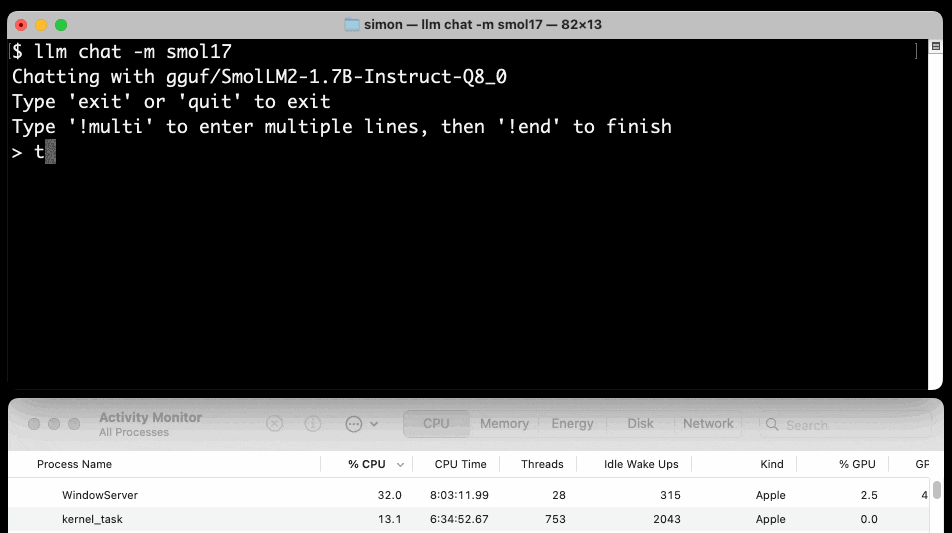
Or at the other end of the scale, here's how to run the 138MB Q8 quantized 135M model:
llm gguf download-model https://huggingface.co/lmstudio-community/SmolLM2-135M-Instruct-GGUF/resolve/main/SmolLM2-135M-Instruct-Q8_0.gguf' -a smol135m
llm chat -m smol135m
The blog entry to accompany SmolLM2 should be coming soon, but in the meantime here's the entry from July introducing the first version: SmolLM - blazingly fast and remarkably powerful .
You can now run prompts against images, audio and video in your terminal using LLM
I released LLM 0.17 last night, the latest version of my combined CLI tool and Python library for interacting with hundreds of different Large Language Models such as GPT-4o, Llama, Claude and Gemini.
[... 1,399 words]Running Llama 3.2 Vision and Phi-3.5 Vision on a Mac with mistral.rs
mistral.rs is an LLM inference library written in Rust by Eric Buehler. Today I figured out how to use it to run the Llama 3.2 Vision and Phi-3.5 Vision models on my Mac.
[... 1,231 words]Un Ministral, des Ministraux (via) Two new models from Mistral: Ministral 3B and Ministral 8B - joining Mixtral, Pixtral, Codestral and Mathstral as weird naming variants on the Mistral theme.
These models set a new frontier in knowledge, commonsense, reasoning, function-calling, and efficiency in the sub-10B category, and can be used or tuned to a variety of uses, from orchestrating agentic workflows to creating specialist task workers. Both models support up to 128k context length (currently 32k on vLLM) and Ministral 8B has a special interleaved sliding-window attention pattern for faster and memory-efficient inference.
Mistral's own benchmarks look impressive, but it's hard to get excited about small on-device models with a non-commercial Mistral Research License (for the 8B) and a contact-us-for-pricing Mistral Commercial License (for the 8B and 3B), given the existence of the extremely high quality Llama 3.1 and 3.2 series of models.
These new models are also available through Mistral's la Plateforme API, priced at $0.1/million tokens (input and output) for the 8B and $0.04/million tokens for the 3B.
The latest release of my llm-mistral plugin for LLM adds aliases for the new models. Previously you could access them like this:
llm mistral refresh # To fetch new models
llm -m mistral/ministral-3b-latest "a poem about pelicans at the park"
llm -m mistral/ministral-8b-latest "a poem about a pelican in french"
With the latest plugin version you can do this:
llm install -U llm-mistral
llm -m ministral-8b "a poem about a pelican in french"
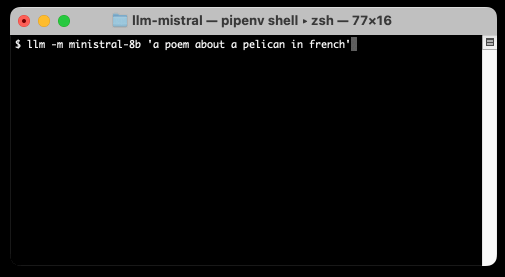
mlx-vlm (via) The MLX ecosystem of libraries for running machine learning models on Apple Silicon continues to expand. Prince Canuma is actively developing this library for running vision models such as Qwen-2 VL and Pixtral and LLaVA using Python running on a Mac.
I used uv to run it against this image with this shell one-liner:
uv run --with mlx-vlm \
python -m mlx_vlm.generate \
--model Qwen/Qwen2-VL-2B-Instruct \
--max-tokens 1000 \
--temp 0.0 \
--image https://static.simonwillison.net/static/2024/django-roadmap.png \
--prompt "Describe image in detail, include all text"
The --image option works equally well with a URL or a path to a local file on disk.
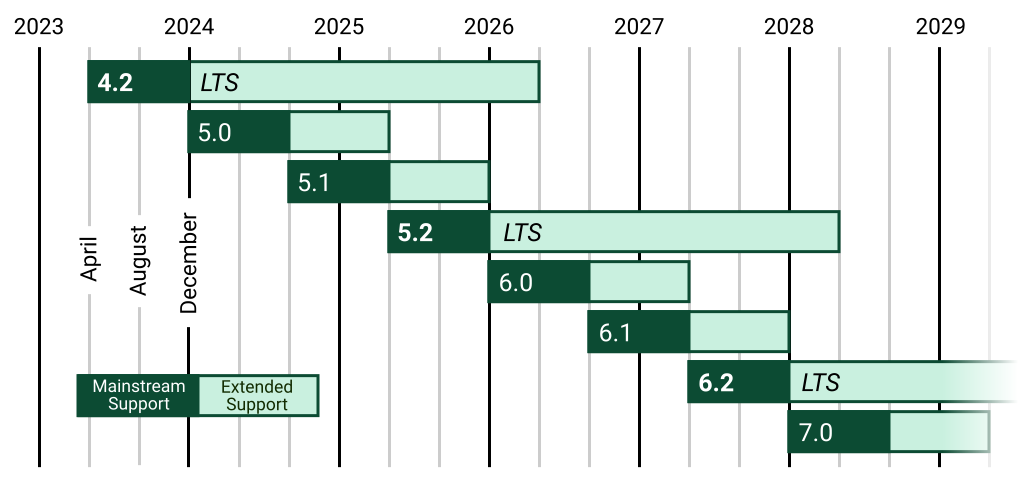
This first downloaded 4.1GB to my ~/.cache/huggingface/hub/models--Qwen--Qwen2-VL-2B-Instruct folder and then output this result, which starts:
The image is a horizontal timeline chart that represents the release dates of various software versions. The timeline is divided into years from 2023 to 2029, with each year represented by a vertical line. The chart includes a legend at the bottom, which distinguishes between different types of software versions.
Legend
Mainstream Support:
- 4.2 (2023)
- 5.0 (2024)
- 5.1 (2025)
- 5.2 (2026)
- 6.0 (2027) [...]
Llama 3.2. In further evidence that AI labs are terrible at naming things, Llama 3.2 is a huge upgrade to the Llama 3 series - they've released their first multi-modal vision models!
Today, we’re releasing Llama 3.2, which includes small and medium-sized vision LLMs (11B and 90B), and lightweight, text-only models (1B and 3B) that fit onto edge and mobile devices, including pre-trained and instruction-tuned versions.
The 1B and 3B text-only models are exciting too, with a 128,000 token context length and optimized for edge devices (Qualcomm and MediaTek hardware get called out specifically).
Meta partnered directly with Ollama to help with distribution, here's the Ollama blog post. They only support the two smaller text-only models at the moment - this command will get the 3B model (2GB):
ollama run llama3.2
And for the 1B model (a 1.3GB download):
ollama run llama3.2:1b
I had to first upgrade my Ollama by clicking on the icon in my macOS task tray and selecting "Restart to update".
The two vision models are coming to Ollama "very soon".
Once you have fetched the Ollama model you can access it from my LLM command-line tool like this:
pipx install llm
llm install llm-ollama
llm chat -m llama3.2:1b
I tried running my djp codebase through that tiny 1B model just now and got a surprisingly good result - by no means comprehensive, but way better than I would ever expect from a model of that size:
files-to-prompt **/*.py -c | llm -m llama3.2:1b --system 'describe this code'
Here's a portion of the output:
The first section defines several test functions using the
@djp.hookimpldecorator from the djp library. These hook implementations allow you to intercept and manipulate Django's behavior.
test_middleware_order: This function checks that the middleware order is correct by comparing theMIDDLEWAREsetting with a predefined list.test_middleware: This function tests various aspects of middleware:- It retrieves the response from the URL
/from-plugin/using theClientobject, which simulates a request to this view.- It checks that certain values are present in the response:
X-DJP-Middleware-AfterX-DJP-MiddlewareX-DJP-Middleware-Before[...]
I found the GGUF file that had been downloaded by Ollama in my ~/.ollama/models/blobs directory. The following command let me run that model directly in LLM using the llm-gguf plugin:
llm install llm-gguf
llm gguf register-model ~/.ollama/models/blobs/sha256-74701a8c35f6c8d9a4b91f3f3497643001d63e0c7a84e085bed452548fa88d45 -a llama321b
llm chat -m llama321b
Meta themselves claim impressive performance against other existing models:
Our evaluation suggests that the Llama 3.2 vision models are competitive with leading foundation models, Claude 3 Haiku and GPT4o-mini on image recognition and a range of visual understanding tasks. The 3B model outperforms the Gemma 2 2.6B and Phi 3.5-mini models on tasks such as following instructions, summarization, prompt rewriting, and tool-use, while the 1B is competitive with Gemma.
Here's the Llama 3.2 collection on Hugging Face. You need to accept the new Llama 3.2 Community License Agreement there in order to download those models.
You can try the four new models out via the Chatbot Arena - navigate to "Direct Chat" there and select them from the dropdown menu. You can upload images directly to the chat there to try out the vision features.
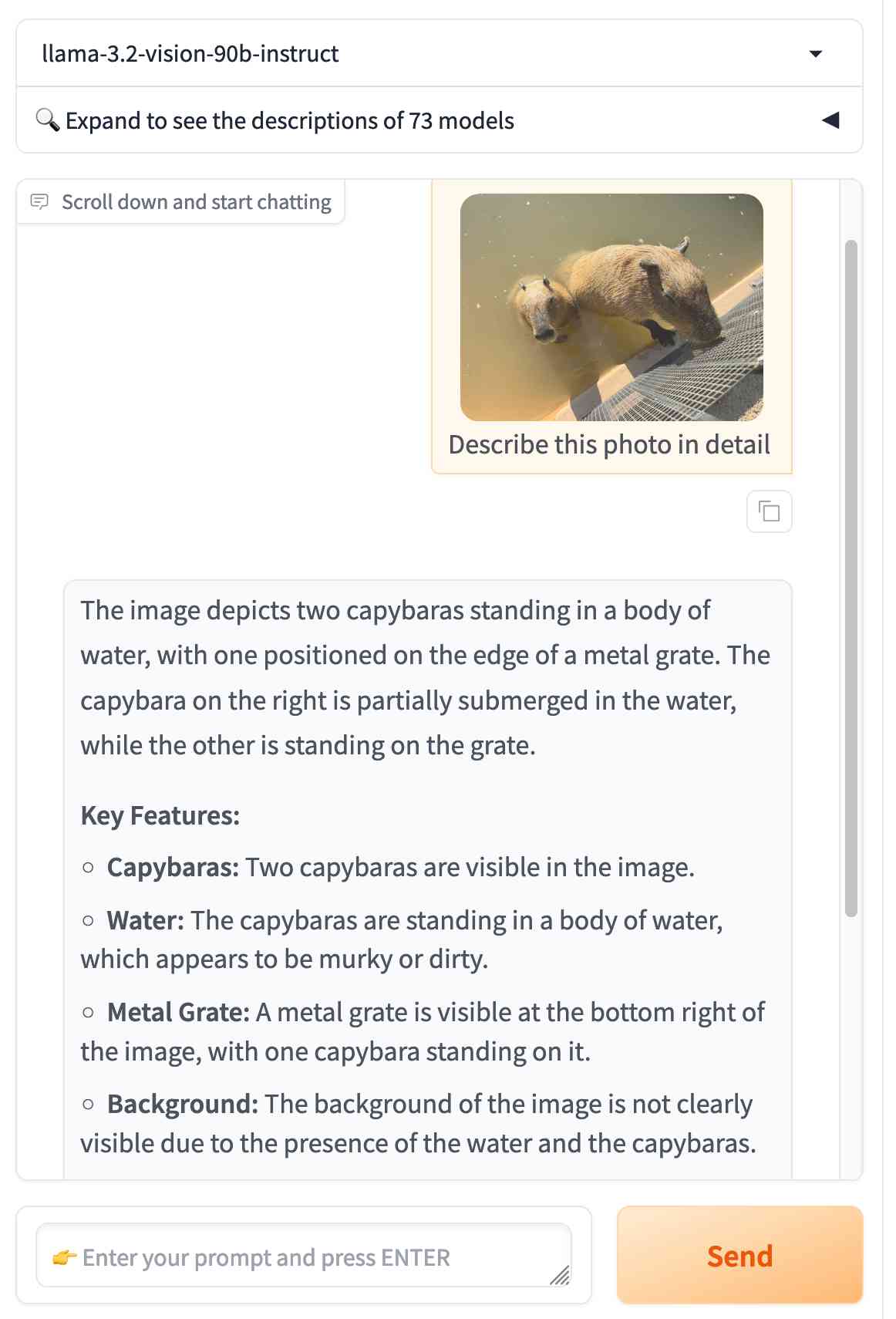
Pixtral 12B. Mistral finally have a multi-modal (image + text) vision LLM!
I linked to their tweet, but there’s not much to see there - in now classic Mistral style they released the new model with an otherwise unlabeled link to a torrent download. A more useful link is mistral-community/pixtral-12b-240910 on Hugging Face, a 25GB “Unofficial Mistral Community” copy of the weights.
Pixtral was announced at Mistral’s AI Summit event in San Francisco today. It has 128,000 token context, is Apache 2.0 licensed and handles 1024x1024 pixel images. They claim it’s particularly good for OCR and information extraction. It’s not available on their La Platforme hosted API yet, but that’s coming soon.
A few more details can be found in the release notes for mistral-common 1.4.0. That’s their open source library of code for working with the models - it doesn’t actually run inference, but it includes the all-important tokenizer, which now includes three new special tokens: [IMG], [IMG_BREAK] and [IMG_END].
Qwen2-VL: To See the World More Clearly. Qwen is Alibaba Cloud's organization training LLMs. Their latest model is Qwen2-VL - a vision LLM - and it's getting some really positive buzz. Here's a r/LocalLLaMA thread about the model.
The original Qwen models were licensed under their custom Tongyi Qianwen license, but starting with Qwen2 on June 7th 2024 they switched to Apache 2.0, at least for their smaller models:
While Qwen2-72B as well as its instruction-tuned models still uses the original Qianwen License, all other models, including Qwen2-0.5B, Qwen2-1.5B, Qwen2-7B, and Qwen2-57B-A14B, turn to adopt Apache 2.0
Here's where things get odd: shortly before I first published this post the Qwen GitHub organization, and their GitHub pages hosted blog, both disappeared and returned 404s pages. I asked on Twitter but nobody seems to know what's happened to them.
Update: this was accidental and was resolved on 5th September.
The Qwen Hugging Face page is still up - it's just the GitHub organization that has mysteriously vanished.
Inspired by Dylan Freedman I tried the model using GanymedeNil/Qwen2-VL-7B on Hugging Face Spaces, and found that it was exceptionally good at extracting text from unruly handwriting:
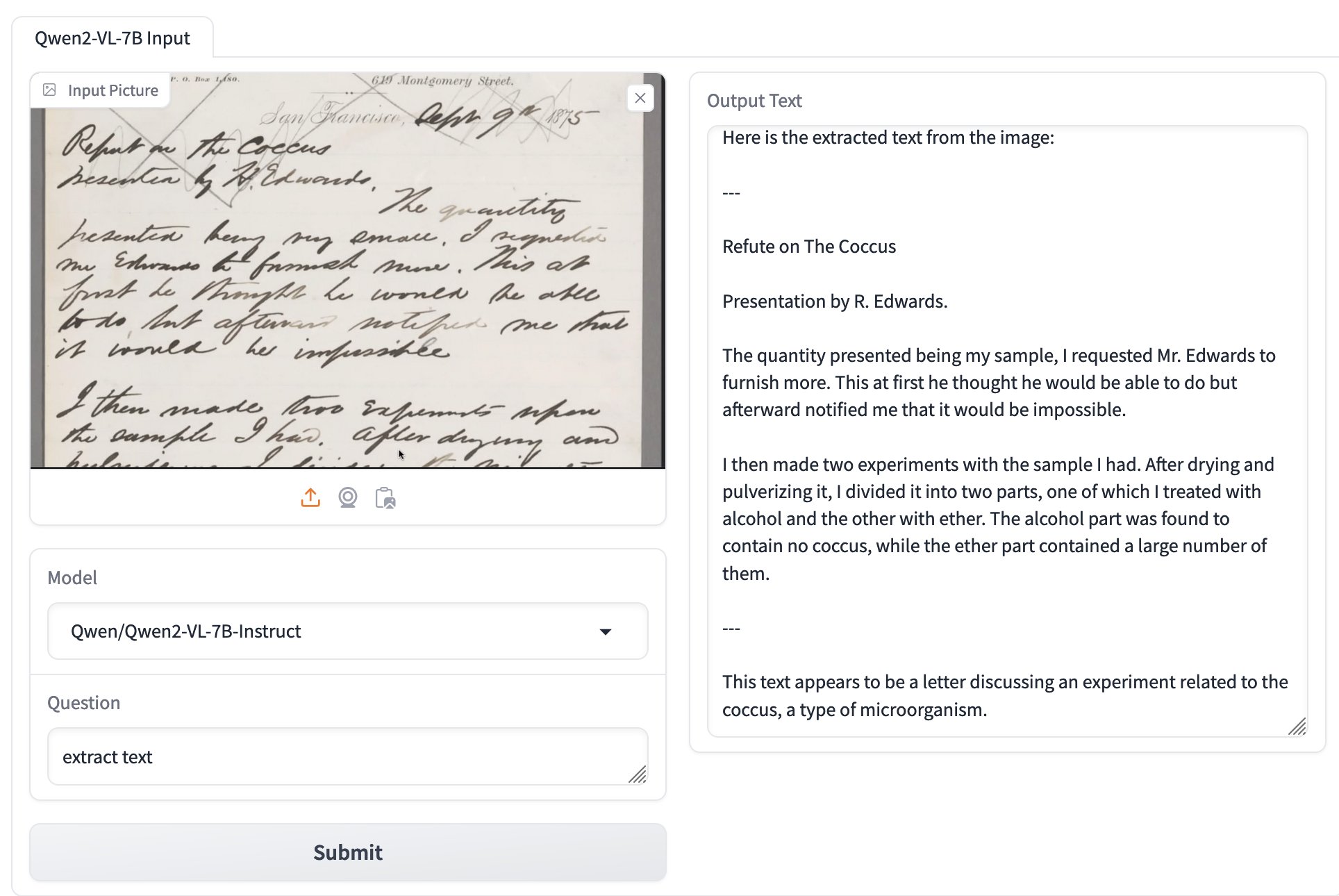
The model apparently runs great on NVIDIA GPUs, and very slowly using the MPS PyTorch backend on Apple Silicon. Qwen previously released MLX builds of their non-vision Qwen2 models, so hopefully there will be an Apple Silicon optimized MLX model for Qwen2-VL soon as well.
llamafile v0.8.13 (and whisperfile)
(via)
The latest release of llamafile (previously) adds support for Gemma 2B (pre-bundled llamafiles available here), significant performance improvements and new support for the Whisper speech-to-text model, based on whisper.cpp, Georgi Gerganov's C++ implementation of Whisper that pre-dates his work on llama.cpp.
I got whisperfile working locally by first downloading the cross-platform executable attached to the GitHub release and then grabbing a whisper-tiny.en-q5_1.bin model from Hugging Face:
wget -O whisper-tiny.en-q5_1.bin \
https://huggingface.co/ggerganov/whisper.cpp/resolve/main/ggml-tiny.en-q5_1.bin
Then I ran chmod 755 whisperfile-0.8.13 and then executed it against an example .wav file like this:
./whisperfile-0.8.13 -m whisper-tiny.en-q5_1.bin -f raven_poe_64kb.wav --no-prints
The --no-prints option suppresses the debug output, so you just get text that looks like this:
[00:00:00.000 --> 00:00:12.000] This is a LibraVox recording. All LibraVox recordings are in the public domain. For more information please visit LibraVox.org.
[00:00:12.000 --> 00:00:20.000] Today's reading The Raven by Edgar Allan Poe, read by Chris Scurringe.
[00:00:20.000 --> 00:00:40.000] Once upon a midnight dreary, while I pondered weak and weary, over many a quaint and curious volume of forgotten lore. While I nodded nearly napping, suddenly there came a tapping as of someone gently rapping, rapping at my chamber door.
There are quite a few undocumented options - to write out JSON to a file called transcript.json (example output):
./whisperfile-0.8.13 -m whisper-tiny.en-q5_1.bin -f /tmp/raven_poe_64kb.wav --no-prints --output-json --output-file transcript
I had to convert my own audio recordings to 16kHz .wav files in order to use them with whisperfile. I used ffmpeg to do this:
ffmpeg -i runthrough-26-oct-2023.wav -ar 16000 /tmp/out.wav
Then I could transcribe that like so:
./whisperfile-0.8.13 -m whisper-tiny.en-q5_1.bin -f /tmp/out.wav --no-prints
Update: Justine says:
I've just uploaded new whisperfiles to Hugging Face which use miniaudio.h to automatically resample and convert your mp3/ogg/flac/wav files to the appropriate format.
With that whisper-tiny model this took just 11s to transcribe a 10m41s audio file!
I also tried the much larger Whisper Medium model - I chose to use the 539MB ggml-medium-q5_0.bin quantized version of that from huggingface.co/ggerganov/whisper.cpp:
./whisperfile-0.8.13 -m ggml-medium-q5_0.bin -f out.wav --no-prints
This time it took 1m49s, using 761% of CPU according to Activity Monitor.
I tried adding --gpu auto to exercise the GPU on my M2 Max MacBook Pro:
./whisperfile-0.8.13 -m ggml-medium-q5_0.bin -f out.wav --no-prints --gpu auto
That used just 16.9% of CPU and 93% of GPU according to Activity Monitor, and finished in 1m08s.
I tried this with the tiny model too but the performance difference there was imperceptible.
Mistral Large 2 (via) The second release of a GPT-4 class open weights model in two days, after yesterday's Llama 3.1 405B.
The weights for this one are under Mistral's Research License, which "allows usage and modification for research and non-commercial usages" - so not as open as Llama 3.1. You can use it commercially via the Mistral paid API.
Mistral Large 2 is 123 billion parameters, "designed for single-node inference" (on a very expensive single-node!) and has a 128,000 token context window, the same size as Llama 3.1.
Notably, according to Mistral's own benchmarks it out-performs the much larger Llama 3.1 405B on their code and math benchmarks. They trained on a lot of code:
Following our experience with Codestral 22B and Codestral Mamba, we trained Mistral Large 2 on a very large proportion of code. Mistral Large 2 vastly outperforms the previous Mistral Large, and performs on par with leading models such as GPT-4o, Claude 3 Opus, and Llama 3 405B.
They also invested effort in tool usage, multilingual support (across English, French, German, Spanish, Italian, Portuguese, Dutch, Russian, Chinese, Japanese, Korean, Arabic, and Hindi) and reducing hallucinations:
One of the key focus areas during training was to minimize the model’s tendency to “hallucinate” or generate plausible-sounding but factually incorrect or irrelevant information. This was achieved by fine-tuning the model to be more cautious and discerning in its responses, ensuring that it provides reliable and accurate outputs.
Additionally, the new Mistral Large 2 is trained to acknowledge when it cannot find solutions or does not have sufficient information to provide a confident answer.
I went to update my llm-mistral plugin for LLM to support the new model and found that I didn't need to - that plugin already uses llm -m mistral-large to access the mistral-large-latest endpoint, and Mistral have updated that to point to the latest version of their Large model.
Ollama now have mistral-large quantized to 4 bit as a 69GB download.
Mistral NeMo. Released by Mistral today: "Our new best small model. A state-of-the-art 12B model with 128k context length, built in collaboration with NVIDIA, and released under the Apache 2.0 license."
Nice to see Mistral use Apache 2.0 for this, unlike their Codestral 22B release - though Codestral Mamba was Apache 2.0 as well.
Mistral's own benchmarks put NeMo slightly ahead of the smaller (but same general weight class) Gemma 2 9B and Llama 3 8B models.
It's both multi-lingual and trained for tool usage:
The model is designed for global, multilingual applications. It is trained on function calling, has a large context window, and is particularly strong in English, French, German, Spanish, Italian, Portuguese, Chinese, Japanese, Korean, Arabic, and Hindi.
Part of this is down to the new Tekken tokenizer, which is 30% more efficient at representing both source code and most of the above listed languages.
You can try it out via Mistral's API using llm-mistral like this:
pipx install llm
llm install llm-mistral
llm keys set mistral
# paste La Plateforme API key here
llm mistral refresh # if you installed the plugin before
llm -m mistral/open-mistral-nemo 'Rave about pelicans in French'
Codestral Mamba. New 7B parameter LLM from Mistral, released today. Codestral Mamba is "a Mamba2 language model specialised in code generation, available under an Apache 2.0 license".
This the first model from Mistral that uses the Mamba architecture, as opposed to the much more common Transformers architecture. Mistral say that Mamba can offer faster responses irrespective of input length which makes it ideal for code auto-completion, hence why they chose to specialise the model in code.
It's available to run locally with the mistral-inference GPU library, and Mistral say "For local inference, keep an eye out for support in llama.cpp" (relevant issue).
It's also available through Mistral's La Plateforme API. I just shipped llm-mistral 0.4 adding a llm -m codestral-mamba "prompt goes here" default alias for the new model.
Also released today: MathΣtral, a 7B Apache 2 licensed model "designed for math reasoning and scientific discovery", with a 32,000 context window. This one isn't available through their API yet, but the weights are available on Hugging Face.
gemma-2-27b-it-llamafile (via) Justine Tunney shipped llamafile packages of Google's new openly licensed (though definitely not open source) Gemma 2 27b model this morning.
I downloaded the gemma-2-27b-it.Q5_1.llamafile version (20.5GB) to my Mac, ran chmod 755 gemma-2-27b-it.Q5_1.llamafile and then ./gemma-2-27b-it.Q5_1.llamafile and now I'm trying it out through the llama.cpp default web UI in my browser. It works great.
It's a very capable model - currently sitting at position 12 on the LMSYS Arena making it the highest ranked open weights model - one position ahead of Llama-3-70b-Instruct and within striking distance of the GPT-4 class models.
Language models on the command-line
I gave a talk about accessing Large Language Models from the command-line last week as part of the Mastering LLMs: A Conference For Developers & Data Scientists six week long online conference. The talk focused on my LLM Python command-line utility and ways you can use it (and its plugins) to explore LLMs and use them for useful tasks.
[... 4,992 words]Introducing Apple’s On-Device and Server Foundation Models. Apple Intelligence uses both on-device and in-the-cloud models that were trained from scratch by Apple.
Their on-device model is a 3B model that "outperforms larger models including Phi-3-mini, Mistral-7B, and Gemma-7B", while the larger cloud model is comparable to GPT-3.5.
The language models were trained on unlicensed scraped data - I was hoping they might have managed to avoid that, but sadly not:
We train our foundation models on licensed data, including data selected to enhance specific features, as well as publicly available data collected by our web-crawler, AppleBot.
The most interesting thing here is the way they apply fine-tuning to the local model to specialize it for different tasks. Apple call these "adapters", and they use LoRA for this - a technique first published in 2021. This lets them run multiple on-device models based on a shared foundation, specializing in tasks such as summarization and proof-reading.
Here's the section of the Platforms State of the Union talk that talks about the foundation models and their fine-tuned variants.
As Hamel Husain says:
This talk from Apple is the best ad for fine tuning that probably exists.
The video also describes their approach to quantization:
The next step we took is compressing the model. We leveraged state-of-the-art quantization techniques to take a 16-bit per parameter model down to an average of less than 4 bits per parameter to fit on Apple Intelligence-supported devices, all while maintaining model quality.
Still no news on how their on-device image model was trained. I'd love to find out it was trained exclusively using licensed imagery - Apple struck a deal with Shutterstock a few months ago.
Ultravox (via) Ultravox is "a multimodal Speech LLM built around a pretrained Whisper and Llama 3 backbone". It's effectively an openly licensed version of half of the GPT-4o model OpenAI demoed (but did not fully release) a few weeks ago: Ultravox is multimodal for audio input, but still relies on a separate text-to-speech engine for audio output.
You can try it out directly in your browser through this page on AI.TOWN - hit the "Call" button to start an in-browser voice conversation with the model.
I found the demo extremely impressive - really low latency and it was fun and engaging to talk to. Try saying "pretend to be a wise and sarcastic old fox" to kick it into a different personality.
The GitHub repo includes code for both training and inference, and the full model is available from Hugging Face - about 30GB of .safetensors files.
Ultravox says it's licensed under MIT, but I would expect it to also have to inherit aspects of the Llama 3 license since it uses that as a base model.
PaliGemma model README (via) One of the more over-looked announcements from Google I/O yesterday was PaliGemma, an openly licensed VLM (Vision Language Model) in the Gemma family of models.
The model accepts an image and a text prompt. It outputs text, but that text can include special tokens representing regions on the image. This means it can return both bounding boxes and fuzzier segment outlines of detected objects, behavior that can be triggered using a prompt such as "segment puffins".
From the README:
PaliGemma uses the Gemma tokenizer with 256,000 tokens, but we further extend its vocabulary with 1024 entries that represent coordinates in normalized image-space (
<loc0000>...<loc1023>), and another with 128 entries (<seg000>...<seg127>) that are codewords used by a lightweight referring-expression segmentation vector-quantized variational auto-encoder (VQ-VAE) [...]
You can try it out on Hugging Face.
It's a 3B model, making it feasible to run on consumer hardware.




